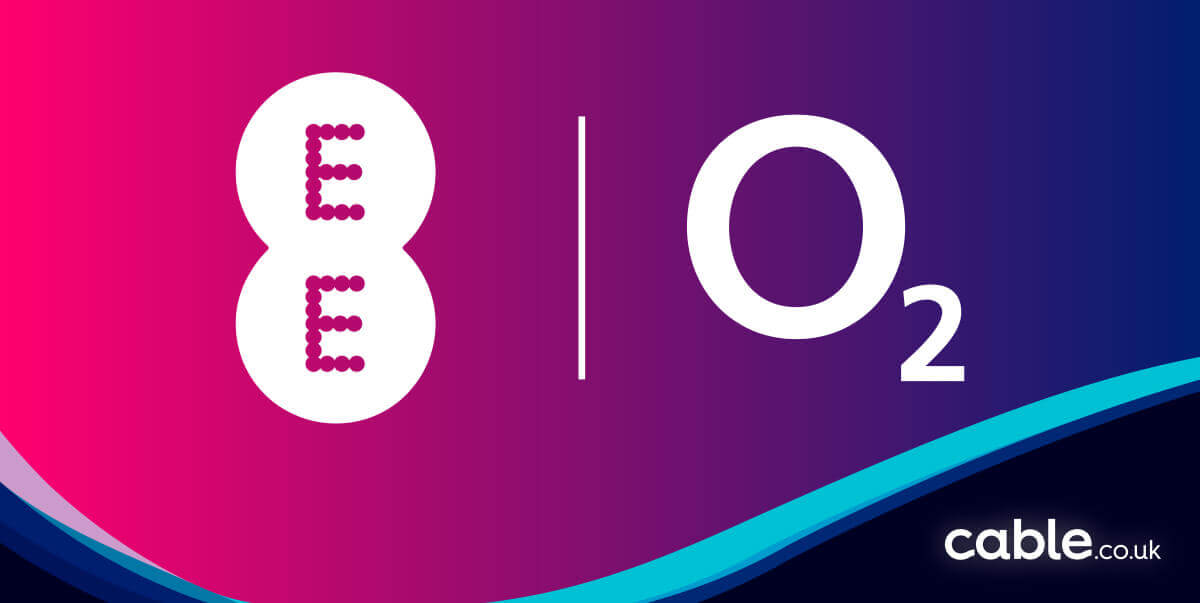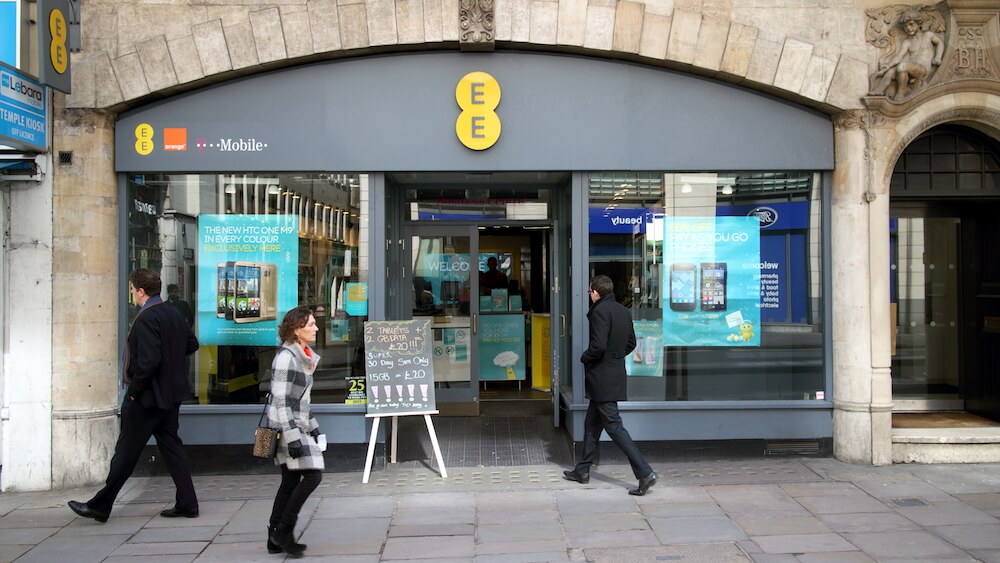Dan Howdle | January 17th, 2022
EE mobile vs O2 mobile: Which is best?
EE and O2 are two of the UK’s main four mobile operators, alongside Three and Vodafone. EE was formed in 2012 by the merger of Orange and T-Mobile, while O2 can trace its roots back to Cellnet and BT Cellnet before it became O2 in 2002. Other providers in the UK piggyback onto one of these networks.

With that history lesson over, it's time to see which of these mobile heavyweights is the right network for you. This will depend on how you will use your mobile phone service. Is it data speed, coverage or reliability that matters most to you? Or perhaps you're more interested in value for money, customer service, consolidating your bills and admin, or maybe you just want the bonuses that might be on offer? Whatever your priority, we've got all the info you need right here.
Price
Winner: O2
Both EE and O2 offer pay-monthly, pay-as-you-go, SIM-only, tablets, laptops, smartwatches and mobile broadband price plans. On a SIM-only basis, the two networks compare favourably on price. When offers are taken out of the equation, O2 tends to offer better value at the lower end of the market, while EE offers more data at the upper end.
If you want a handset, then it’s worth noting that with some handsets, such as the latest iPhone, EE will only let you get one with a high-end price plan. In general, O2 is more flexible on the choice of tariff and also separates the cost of your handset and your airtime. This means that once your minimum term has expired, you stop paying for the phone and only pay for your allowance. With O2’s custom plans, you can choose how much you want to pay up front and spread the remaining cost of your handset over the length of your contract. Plus, the handset part of the contract isn’t subject to price increases in line with inflation (whereas the airtime part is).
When it comes to pay-as-you-go, both providers offer bundles of calls, texts and data for you to buy with your credit. These packages are relatively similar in terms of cost and allowances, but if you want ‘classic’ pay-as-you-go where you only pay for what you use, then O2 is the clear winner, giving you the option to roll over your unused monthly data allowance.
Data speed and limits
Winner: EE
The speed of EE’s 4G network is unparalleled within the UK. As the first UK operator to launch 4G – back in 2012 – it has had a head start on the competition and has continually rolled out upgrades across its network. In 2019, EE was the first to launch 5G in the UK, and is available in more towns and cities than any other network. 5G works in addition to the existing 4G network, instead of replacing it, offering better reliability and connectivity.
Superfast 5G speeds are now available on all EE plans, but you need to have a 5G phone to get 5G speeds. 5G has the potential for speeds to reach up to 1000 Mbps (or 1Gbps), but this will only happen once the entire 5G network has been rolled out. For now, if you have a 5G phone, you can get an average speed of 100Mbps, compared to 4G with an average speed of 30Mbps with EE’s current plans. EE’s plans give you the fastest possible speeds available in your area and on your device.
O2 offers no such restriction on speed, but it is slower than EE. However when you take into account the fact that EE’s fastest speeds are only available in certain parts of the country, it’s worth checking how each network behaves in your area.
Network coverage
Winner: EE
Simply put, EE has the best 4G and 5G network of any UK mobile operator. Its basic LTE service is available to more than 99 per cent of the UK population, although it must be noted that double speed 4G is largely limited to urban areas and ‘4G+’ is restricted to certain parts of major cities.
While the initial focus of 4G rollout was on population coverage, EE is now making a big deal about ‘geographic coverage’ in a bid to push home its advantage. Its network is currently available to 85 per cent of the UK landmass and the operator wants to increase this to 95 per cent by the end of the decade.
O2 has made significant gains in recent years. O2’s 4G network now covers over 99% of the UK population indoors, and as part of the Shared Rural Network agreement, alongside other UK operators, Ofcom and government, they’re working to boost UK landmass coverage from 64% to 88% for 4G, and continuing to roll out 5G across the UK.
If you want to take advantage of either network, but don’t want to sign up for EE or O2, then you might want to consider one of the ‘virtual operators’ that use the same infrastructure. For example, Virgin Media uses EE and Sky Mobile is on O2.
Customer service
Winner: O2
O2 has traditionally been strong in customer service, and regulator Ofcom’s most recent reports on customer satisfaction and complaints would appear to suggest that this is still the case. 62 per cent of O2 customers are happy with how their complaint was handled and 91 per cent are happy with the operator overall – both above average for UK mobile operators.

However, EE is not far off. 56 per cent of customers are happy with complaint handling and 92 per cent are satisfied with their overall service. Both of these are in line with the industry average.
In terms of total complaints, Ofcom receives one complaint per 100,000 EE customers EE and two complaints per 100,000 O2 mobile customers – below the industry average of five. In this one, it’s a dead heat.
Benefits and features
Winner: Draw
EE and O2 are fairly well matched with regards to added extras, and it comes down to whether you value services, premium content or experiences. With EE you can choose up to 3 Smart Benefits depending on the plan you choose. Smart Benefits include free Apple Music, the BT Sport Ultimate app, Netflix and more.
With O2, you get access to Priority, the UK’s largest digital loyalty programme. O2 will give you treats like free coffee, restaurant discounts and the ability to get gig tickets up to 48 hours before anyone else. On selected O2 Refresh phone, tablet and sim only contracts, you'll can pick a free extra for up to 12 months. Extras include access to Disney+, Amazon Music Unlimited, Amazon Prime Video, Audible and more.
Both EE and O2 options are pretty neat, so it really does come down to preference.
Going overseas
Winner: O2
When the UK was in the European Union, mobile phone service providers were banned from charging customers extra fees to use their UK allowance of minutes, texts and data (subject to 'fair use' limits) in any EU country. Post-Brexit, things have changed.
Most major mobile operators have reintroduced roaming charges, with some scheduled to start in 2022. EE will charge customers a £2 per day roaming fee from 3 March 2022, but only those who took out new contracts or renewed contracts after 6 July 2021 are affected. O2 is one of the few operators that hasn’t introduced roaming charges for EU travel. Whether you’re on Pay Monthly or Pay As You Go, you can use your O2 data, minutes and texts at no extra cost across over 45 countries in O2’s Europe Zone.
For travel beyond Europe, EE has a handy roaming calculator on its website for customers to determine how much they'll pay depending on the type of contract, existing add-ons or Smart Benefits that cover roaming, and the destination. O2 has an optional Travel Bolt On that covers roaming in most countries beyond Europe for an additional charge of £5 per day.
EE pay-monthly customers on a Max Plan, with a Roam Abroad Pass or the Roam Further add-on can use almost all the standard allowances as you would at home, at no extra cost (but calls to US and other non-EU numbers will incur extra charges). EE does promise to provide you with usage alerts and data caps, but this could be an expensive way to use your phone depending on where you go.
If roaming is the most important criterion between choosing either EE or O2, then it comes down to a choice between roaming destination(s) and cost. When it comes to roaming, O2 has the advantage, unless you desperately need 4G or 5G and (preferably) your employer will foot the bill.
Conclusion
As you can see, both operators have their pros and cons, but the choice is actually quite simple. If you want the best network and don’t care how much you spend, then EE is the one for you. It has the fastest speeds and best coverage, while there are some nice extras for you to use your data on. But if you want more for your money and don’t mind slower, if still perfectly good speeds, then it’s worth checking out O2.